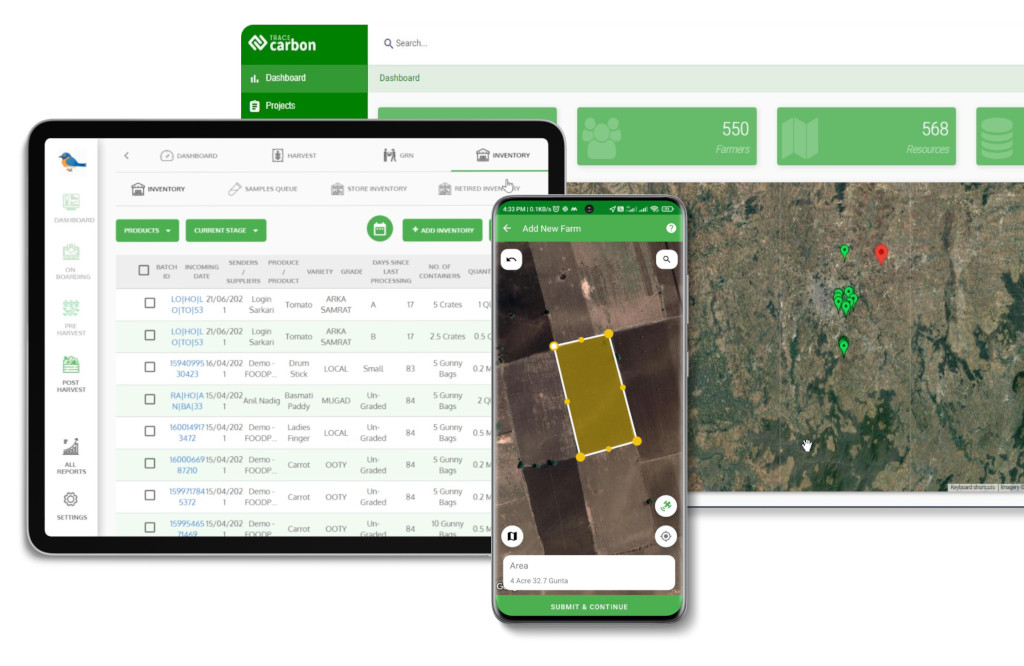Contact: +91 99725 24322 |
Menu
Menu
Quick summary: Discover why accurate mapping of Ghana’s cocoa farms is the critical first step toward EUDR compliance. Learn how to meet EU requirements, avoid shipment risks, and build buyer trust with verified traceability.

Your EU shipment depends on a map — literally. As the EU Deforestation Regulation (EUDR) deadline draws near, cocoa exporters and cooperatives in Ghana are under mounting pressure to prove that their supply chains are deforestation-free and fully traceable. For Ghana cocoa farms, this means more than just sourcing quality beans — it means providing accurate geolocation data for every plot of land involved in production.
Without verified farm mapping, even compliant cocoa can be flagged at customs, delayed, or rejected entirely. In short: no map, no market. Farm mapping isn’t just a compliance checkbox — it’s the first, non-negotiable step in building an EUDR-ready supply chain that protects both your shipments and your reputation.
Key Takeaways
EUDR isn’t just another sustainability initiative. It’s a legally binding regulation that demands hard proof, not well-meaning claims.
And for cocoa exporters in Ghana, that means documenting exactly where your beans come from — down to the plot — and showing that those plots haven’t been deforested since December 31, 2020.
Sounds overwhelming? You’re not alone.
Many supply chain managers are asking:
“Do I need to map every smallholder farm?”
“Is a GPS point enough — or do I need full polygon boundaries?”
“How do I prove no deforestation happened after 2020 if I’ve never used satellite data before?”
You must provide GPS coordinates for every cocoa farm that contributes to your EU-bound shipment.
This can be:
This data must be accurate, verifiable, and linked to a specific farmer or supplier.
Why it matters: Without geolocation, there’s no way to run deforestation checks or pass EU customs.
If any cocoa was grown on land cleared after this date, it’s considered non-compliant — no matter how sustainable the rest of your supply chain is.
You’ll need to:
The burden of proof is on you — not your buyer, not your certifier.
Before your product enters the EU market, you must submit a Due Diligence Statement (DDS) to the EU Information System (EU-IS).
This includes:
Because cocoa from Ghana feeds into some of the biggest chocolate and food brands in Europe — and they won’t take chances with compliance.
If you can’t trace it, prove it, and declare it with confidence, you risk delays, fines, and losing EU buyer contracts — even if your beans are ethically grown.
But with the right systems in place, this becomes a competitive edge, not a compliance headache.
If you’re an exporter, cooperative, or sustainability lead working with Ghana’s cocoa supply chain, here’s the hard truth:
You can’t comply with EUDR without accurate farm mapping.
No map, no shipment. It really is that simple.
A lot of exporters ask:
“Can’t we just use the GPS points we already have?”
“Do we really need polygons for every farmer?”
“What if we don’t have every plot mapped in time — can we still export?”
Here’s the problem: incomplete or inaccurate maps can trigger false positives — or worse, hidden deforestation risks.
And under EUDR, that means:
Even if your cocoa is clean, if your maps are wrong, the EU can’t verify it — and they won’t take your word for it.
If you think of compliance like building a house, then mapping is the foundation.
Everything else — deforestation checks, farmer declarations, batch traceability — depends on having accurate plot-level data.
Without a solid map, you’re just guessing.
And when the EU asks for proof, guesswork won’t cut it.
Discover how TraceX helped local suppliers trace cocoa to the plot level, onboard smallholders, and ensure deforestation-free exports to the EU.
Read the full case study and get inspired to build a compliant, transparent cocoa supply chain.
These are the questions they’ll ask — and your farm mapping needs to answer them:
If you can’t confidently answer those questions, your shipment is at risk — even if every bean is sustainably produced.
Start by compiling a master list of all farms contributing to your EU-bound cocoa supply.
This includes:
Why it matters:
If a farm isn’t on your list, it can’t be mapped — and untraceable cocoa = non-compliant cocoa under EUDR.
Equip your field agents with GPS-enabled mobile apps that allow them to walk the actual boundary of each farm — drawing a digital polygon in real time.
This is better than point-based GPS because:

As you map, collect the essential “supporting documents” that EU buyers and auditors will expect:
After collection, your job isn’t done. You need to verify:
This can be done via:

Manually mapping thousands of smallholder farms, collecting land records, and managing due diligence files sounds like a compliance nightmare — especially with EUDR deadlines looming.
That’s where TraceX’s EUDR Compliance Platform comes in. We don’t just digitize your data — we give you a field-to-audit system that’s purpose-built for cocoa exporters, cooperatives, and sustainability teams navigating the EUDR landscape.
Field officers can map cocoa plots directly in the field, even in remote Ghanaian communities with no network.
No more paperwork. No more guesswork. Just clean, verifiable maps — collected in hours, not weeks.
Each mapped plot is tied to a real farmer profile — not just a GPS dot.
This builds a compliant audit trail — and creates trust with EU buyers who want farmer-level transparency.
Struggling to onboard farmers for EUDR compliance?
See how TraceX helped streamline onboarding with integrated KYC validation—making it faster, easier, and fully audit-ready.
Read the case study and learn how to scale trust from the ground up.
Once farms are mapped, TraceX lets you export geolocation data instantly in EU-accepted formats like:
Perfect for sharing with certification bodies, third-party auditors, or uploading into EU-IS during due diligence.
Still stuck managing farm data in messy spreadsheets?
See how one agribusiness leader used TraceX’s KML & Excel tools to digitize 1,000+ farms—faster, cleaner, and fully EUDR-compliant.
Read the case study to see the transformation step-by-step.
TraceX simplifies your most time-consuming task: generating and submitting the Due Diligence Statement (DDS).
It’s everything you need to get your cocoa shipment across EU borders — without back-and-forth stress.
Not every farm you source from will have the same level of risk — and under EUDR, that matters.
TraceX helps you:
Now you can confidently manage complex supply chains — and still submit clean, defensible batches for EUDR.
With TraceX, you get more than just a digital map. You get:
Because under EUDR, cocoa traceability isn’t just compliance — it’s currency.
And TraceX makes sure yours is clean, verifiable, and future-proof.
If you’re managing a cocoa export business, a cooperative, or even a sustainability team in Ghana, farm mapping might not feel like the most urgent task today.
But here’s the uncomfortable truth:
The longer you delay farm mapping, the closer you get to non-compliance — and the greater the risk of losing everything you’ve built.
Because EUDR isn’t coming — it’s here. And it’s not just a guideline. It’s the law.
Without mapped plots, you can’t generate Due Diligence Statements. Without those, your cocoa won’t clear EU customs. Period.
Even if your cocoa is ethically grown and certified — if you don’t have geolocation data for the farms, you’re out of compliance.
And delayed shipments lead to damaged client relationships, broken contracts, and penalties you can’t afford.

The EUDR requires you to prove — not claim — that your cocoa isn’t linked to deforestation after Dec 31, 2020.
If your supply chain is flagged as risky or unverified, you could face:
You might be wondering:
“What if we just do spot-checks or partial mapping?”
That’s not enough anymore. The regulation demands full, farm-level traceability for every EU-bound shipment.
European buyers are now shifting fast. They don’t just want certifications — they want polygon maps, timestamped data, and satellite overlays.
If you can’t provide that, they’ll move to another supplier who can.
Because in a competitive global market, buyers aren’t waiting for you to catch up.
They’re looking for partners who are ready now.
Let’s say you’ve spent years building a reputation as a “responsible” exporter or cooperative.
What happens when your name shows up in an EU deforestation alert or a watchdog report?
All because you didn’t map the farms.
It’s not just about compliance. It’s about protecting your credibility — and the trust you’ve earned with customers, certifiers, and communities.
Most Ghanaian cocoa is sustainably grown. But under EUDR, that’s not enough.
You have to show it — plot by plot, backed by real data.
TraceX helps you do that faster, smarter, and at scale — so you don’t fall behind and lose access to the EU market while your competitors race ahead.
EUDR compliance doesn’t start with paperwork — it starts in the field. For Ghana’s cocoa exporters and cooperatives, mapping farms accurately isn’t just about avoiding shipment delays or audit rejections. It’s about proving the integrity of your supply chain, building trust with buyers, and unlocking access to premium markets.
With a digital-first approach to farm mapping, you’re not just meeting regulation — you’re getting ahead of it. TraceX helps you turn field data into verified sourcing power, so you can grow your business with confidence, credibility, and compliance.
Yes. Every farm contributing to EU-bound cocoa must be geolocated using a GPS point or polygon, and linked to a due diligence statement. Without this, your shipment may be held or rejected at EU customs.
While GPS points may be accepted for smallholder farms, polygon mapping is recommended and preferred — especially in high-risk areas. It provides stronger accuracy and audit defense.
Shipments missing mapped plots may be considered non-compliant. To mitigate this, companies can use strategies like “Declaration in Excess” and prioritize mapping high-volume farms first — ideally supported by platforms like TraceX for scale and speed.
